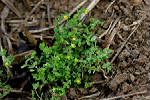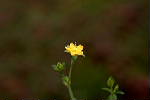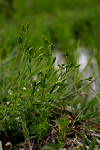



Botany Biology Phenology Ecology Distribution Agricultural importance Cultural control Chemical control
| Description : | Terrestrial, annual, tufted herb, up to 40 cm tall. Roots fibrous, white or brown. Stem erect or procumbent, quadrangular, solid, glabrous. Stipules absent. Leaves simple, not lobed or divided, opposite, sessile, ovate, less than 2 cm long/wide, glabrous on both sides, dots present, margin entire, apex obtuse, base cordate, parallel-veined. Flowers bisexual, grouped in a terminal one to few-flowered cyme, stalked, petals 5, yellow. Fruits a capsule, opening with 3 valves. |